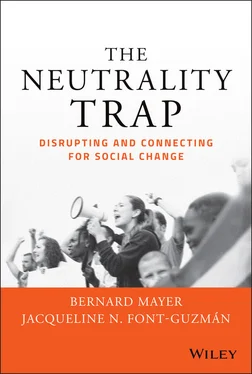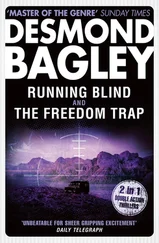Bernard S. Mayer - The Neutrality Trap
Здесь есть возможность читать онлайн «Bernard S. Mayer - The Neutrality Trap» — ознакомительный отрывок электронной книги совершенно бесплатно, а после прочтения отрывка купить полную версию. В некоторых случаях можно слушать аудио, скачать через торрент в формате fb2 и присутствует краткое содержание. Жанр: unrecognised, на английском языке. Описание произведения, (предисловие) а так же отзывы посетителей доступны на портале библиотеки ЛибКат.
- Название:The Neutrality Trap
- Автор:
- Жанр:
- Год:неизвестен
- ISBN:нет данных
- Рейтинг книги:3 / 5. Голосов: 1
-
Избранное:Добавить в избранное
- Отзывы:
-
Ваша оценка:
- 60
- 1
- 2
- 3
- 4
- 5
The Neutrality Trap: краткое содержание, описание и аннотация
Предлагаем к чтению аннотацию, описание, краткое содержание или предисловие (зависит от того, что написал сам автор книги «The Neutrality Trap»). Если вы не нашли необходимую информацию о книге — напишите в комментариях, мы постараемся отыскать её.
The Neutrality Trap,
The Neutrality Trap
The Neutrality Trap — читать онлайн ознакомительный отрывок
Ниже представлен текст книги, разбитый по страницам. Система сохранения места последней прочитанной страницы, позволяет с удобством читать онлайн бесплатно книгу «The Neutrality Trap», без необходимости каждый раз заново искать на чём Вы остановились. Поставьте закладку, и сможете в любой момент перейти на страницу, на которой закончили чтение.
Интервал:
Закладка:
Puerto Ricans' expression of their culture gave life, power, and unity to the movement. Puerto Ricans ousted the governor through dancing, painting, poetry, acrobatics, kayaking, scuba diving, skydiving, singing, motorcycling, horseback riding, biking, pot banging, kite flying, improvisational comedy—and more. The arts and humanities took over the land, water, air, and space in Puerto Rico.
We have seen similar efforts to confront oppression and authoritarianism in Hong Kong, Myanmar, Chile, Russia, and elsewhere. In each case, the pushback was significant and has led to violence, mass arrests, and an increase in the repressive nature of the regime.
In the face of such ferocious resistance, it is easy to become disillusioned about the possibility of progress against oppression. These upheavals are manifestations of how in the face of enduring conflicts creative approaches to conflict escalation can move systems toward democracy and inclusion. But progress does not occur in a neat, linear, unidirectional way, and we can hold no certainty about end results or unintended consequences.
Of course, not all social movements are aimed at confronting oppression or injustice. Some movements (e.g. the Tea Party or the Proud Boys) are intended to maintain privilege and dominance. The efforts to subvert the outcome of the 2020 presidential election in the United States were the expression of resistance to the empowerment of women and minorities. The struggles between progressive and regressive forces are ancient and enduring, and the struggle for justice is powerful but not straightforward.
Acting Small, Dreaming Big
Beverly Daniel Tatum (2017, 340–341) argues that the antidote for feeling despair when confronting injustice is to focus our energy on our “sphere of influence.” What and whom can we influence? What are small actions under our control that can lead to fulfilling a dream of a beloved community? How can we expand and strengthen our network? How can we build community? How can we best use our talents? Acting small means using our agency, as limited as it may be at times, to its strategic maximum while keeping our focus on the dream that motivated us in the first place. If we are part of the system, then we can change the system by changing how we behave within the system.
A popular environmental slogan (still seen on many bumper stickers) from about 30 years ago—Think Globally, Act Locally—conveys both a vision and strategy. To understand the scale of the challenge posed by global warming, species extinction, extreme weather, and other environmental disasters, we have to take a global perspective. But how do we promote an effective approach to these challenges? We need a movement with a global vision and a local presence.
For example, how do we combat an economic system that has led to increasing economic inequality? How do we contend with the rise of authoritarian populism? What about nativism, racism, misogyny, imperialism? All of these are global phenomena. The rise of Donald Trump is not disconnected from that of Victor Orban in Hungary, Rodrigo Duterte in the Philippines, or Jair Bolsonaro in Brazil. The global dimensions of these challenges must be understood if movements for change are to flourish. But building effective movements for change requires local action, local leaders, and a focus on local manifestations of global problems. Global networks are important, as are global spokespersons, but the real work takes place in our local communities and organizations where the focus may be affordable housing, police‐community relationships, or sexual misconduct at a local high school.
This is related to a central challenge that mediators are very familiar with: How do you connect the underlying concerns or issues that people are trying to come to grips with in conflict, to the tangible manifestations of them that tend to be foremost in their thoughts and emotions?
Divorced parents may be in conflict over how to share time with their children over Christmas or which school they should attend or where they should spend every other Wednesday night, but these details almost always represent more basic concerns about parenting, decision making, boundaries, and communication.
A neighborhood that is up in arms about plans to locate a homeless shelter nearby may be worried about safety and property values, and there are likely racial biases at work as well. But the focus of discussion instead is usually on parking, traffic, lighting, and design. Almost always, the most strenuous arguments start out about the specifics, but the real problem lies at a deeper or more systemic level. Pretending it is just about traffic and safety can enable racist policies, but ignoring those concerns can prevent genuine engagement from occurring. This challenge is not just about the geographical reach or expression of a conflict. It also involves the systemic versus behavioral view, the immediate concerns versus the long‐term challenge, individual action versus communal responsibility, and the action of groups versus that of leaders. Social movements must find a way to attend to the immediate and local while maintaining a long‐term and far‐reaching focus.
Disrupting for What: A Guiding Vision
Dr. King's Beloved Community is a global vision in which all people can share in the wealth of the earth. In the Beloved Community, poverty, hunger, and homelessness will not be tolerated because international standards of human decency will not allow it. Racism and all forms of discrimination, bigotry, and prejudice will be replaced by an all‐inclusive spirit of sisterhood and brotherhood. In the Beloved Community, international disputes will be resolved by peaceful conflict‐resolution and reconciliation of adversaries, instead of military power. Love and trust will triumph over fear and hatred. Peace with justice will prevail over war and military conflict.
—The King Center, n.d.
Democratic socialists believe that both the economy and society should be run democratically—to meet public needs, not to make profits for a few. To achieve a more just society, many structures of our government and economy must be radically transformed through greater economic and social democracy so that ordinary Americans can participate in the many decisions that affect our lives …
Democratic socialists do not want to create an all‐powerful government bureaucracy. But we do not want big corporate bureaucracies to control our society either. Rather, we believe that social and economic decisions should be made by those whom they most affect.
—Democratic Socialists of America, 2020
Social movements are often accused of being clearer about what is wrong and must change than about their vision for the future. This is mostly an undeserved criticism because it's impossible to know precisely how large‐scale systems will reorganize or to predict the future. We have to start with an understanding of what is not working now. Nonetheless, the development of a sense of what kind of society or world we want is essential to powerful change efforts, as is a roadmap for how to get there.
During the first half of the 20th century (and earlier), progressive movements were often motivated by a vision of society founded in socialist ideology. But, particularly in the United States, socialism (mostly unfairly) became associated with support for authoritarian regimes and with intrusive governmental bureaucracies. For much of the last 50 years, socialist ideology has not provided the motivating vision it once did. However, more recently, especially with the presidential campaigns of Bernie Sanders, the ideology of Democratic Socialism has seen a revival. Nonetheless as seen in the last US election, associating a cause (universal healthcare or the Green New Deal, for example) or a politician with socialism continues to be an effective tactic for those seeking to resist change.
Читать дальшеИнтервал:
Закладка:
Похожие книги на «The Neutrality Trap»
Представляем Вашему вниманию похожие книги на «The Neutrality Trap» списком для выбора. Мы отобрали схожую по названию и смыслу литературу в надежде предоставить читателям больше вариантов отыскать новые, интересные, ещё непрочитанные произведения.
Обсуждение, отзывы о книге «The Neutrality Trap» и просто собственные мнения читателей. Оставьте ваши комментарии, напишите, что Вы думаете о произведении, его смысле или главных героях. Укажите что конкретно понравилось, а что нет, и почему Вы так считаете.












